
Archangel Michael with acts. The main icon of the Archangel Cathedral in the Moscow Kremlin, 1410-th
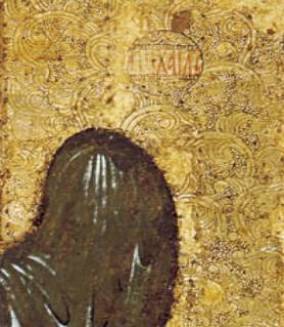
Carved primer of central part background
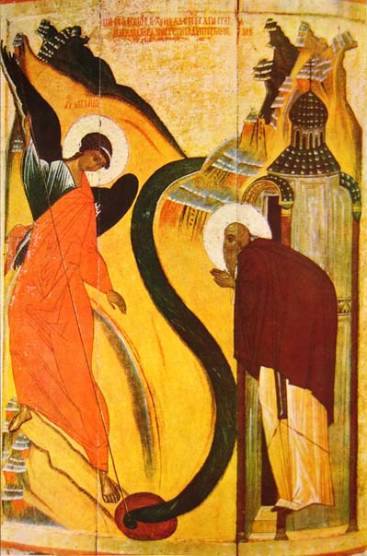
Miracle in Choane. Early XV.
Image of Holy Trinity on the icon of Michael
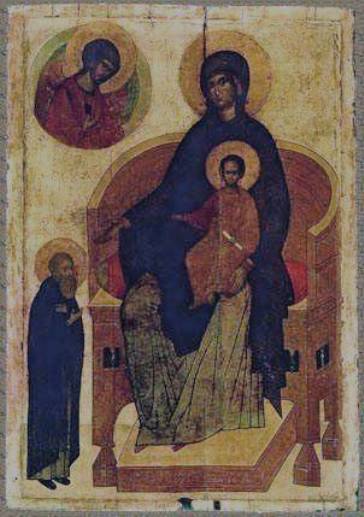
St. Sergius in front of Theotokos with Archangel Michael
Roublev "Trinity". Detail.
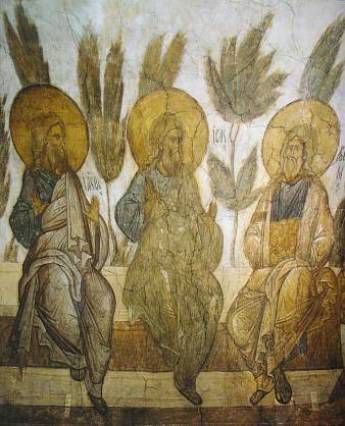
Jacob, Isaac, Abraham. Fresco of Roublev and Daniel.
ARCHANGEL MICHAEL AND IMAGE OF HOLY TRINITY. L.R.
The Kremlin icon of Archangel Michael with acts
Heroic struggle against the Horde has led to strengthening of a cult of archangel Michael in Russia. This struggle was comprehended in an apocalyptic context of the world fight of the good with evil. Sergius of Radonezh, inspiring the people and princes to a great feat, appealed the Russian people to the unity "in image of a Holy Trinity". Sending with Dmitry Donskoy two monk-warriors of Peresvet and Osliabya, Sergius has shown, that spiritual war of monks against "ghosts of evil" – the phenomenon of the same order, that battle with impious Horde.
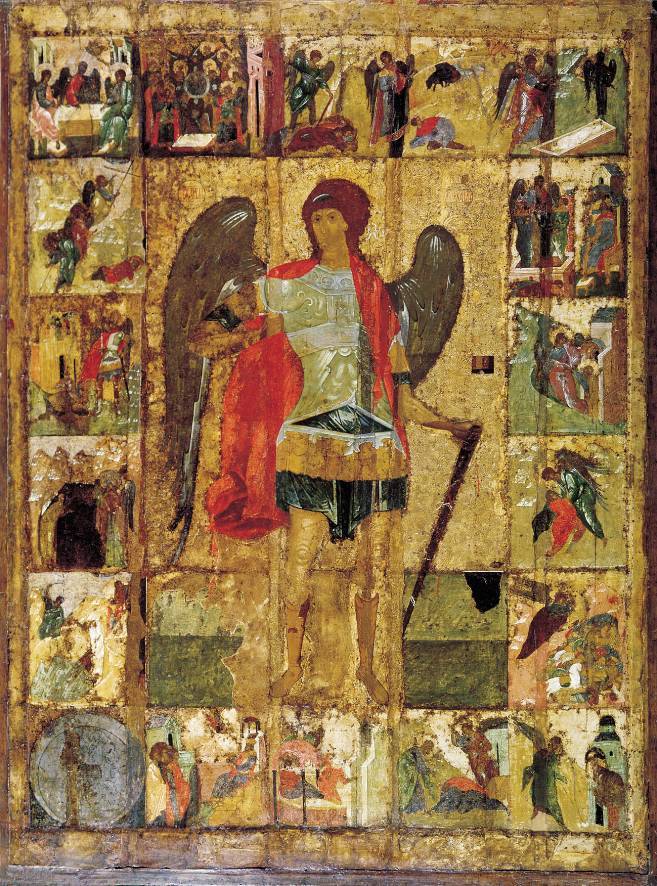 "The legend about Mamay slaughter" compares Mamay invasion with a capture of Jerusalem by Nebuchadnezzar and informs, that before the beginning of a campaign Dmitry with the brother "went to the church of Michael and worshiped his holy image". The chronicle "About the battle on Don" asserts, that the regiment of saint martyrs and angels helped Russian warriors and at the head of them was archangel Michael.
"The legend about Mamay slaughter" compares Mamay invasion with a capture of Jerusalem by Nebuchadnezzar and informs, that before the beginning of a campaign Dmitry with the brother "went to the church of Michael and worshiped his holy image". The chronicle "About the battle on Don" asserts, that the regiment of saint martyrs and angels helped Russian warriors and at the head of them was archangel Michael. On background of these events it is not casual an occurrence of the well-known icon "Archangel Michael with acts" in Archangel Cathedral of the Moscow Kremlin. Experts estimate this icon extremely highly.
"The genius having created this icon, – according to competent opinion of K.G.Tihomirova, – is not the pupil, an imitator or the follower: before us – the colleague and interlocutor of Sergius Radonezhsky, Theophan the Greek, Andrey Rublev. Together with them, this great artist was laying the corner stones of Russian national culture".
Chronicle informs, that icon customer was Dmitry Donskoy widow Eudoxia, who had had "the vision" of archangel Michael and wished to embody this vision in icon. According to the legend, as a result of vision she has lost the speech and was trying to explain by gestures to the painter, what he should depict. Only after the third attempt he managed to carry out the task and then ability to speak has returned to Eudoxia.
The icon has a number of the prominent features, one of which – the raised sword giving to the image intense, warlike, apocalyptic character. To any deviation from the established canon in iconography was always given the special, exclusive sense. "Raising" sword by Michael testified: the terms are expired. Now is coming "Michael, the prince great, standing up for sons of your people" (Dan.12:1).
It is absolutely unique a gold background, carved on primer.
Specialists connect the ornament (stalks with leaves) with an earthly paradise from which have been expelled Adam and Eve. However for that epoch of a spiritual life of Russia a vital question was not the theme of «exile from paradise», but a theme of "return into paradise".
From this point of view the deciduous ornament is direct symbol of "thousand-year kingdom" (Rev.Ch.20) and Michael acts here as the king and the defender of an earthly paradise from forces of evil. That is he, "who was to rule all nations with a rod of iron" (Rev.12:5) which he holds in the left hand. He does not anymore expel the man from paradise, but with fight leads him there, to “the promised earth”.
The border scene on the right below represents "the Miracle of archangel Michael in Choane", which has an apocalyptic sense. We will remind, that angular stamps in such icons are devoted to acts which the painter considers as the most important.
The city of Choane was constructed on a place of the Colossae destroyed by earthquake in 60 AD. According to the legend, here, on a place where Michael has defeated a huge serpent, the salutary source has opened and the chapel of the archangel name has been constructed. Researchers connect Michael cult in Choane with Hermes cult, the organizer of cosmos knowing also secrets of the underworld. Various legends narrates, how the "impious Hellens" have arranged a dam near the mountain, which divided two rivers and, having accumulated much water, have directed it down on a source and a chapel. On a pray of priest Archip, archangel Michael was appeared and, having struck a spear upon the earth, has opened a crevice by which water was drained.
In the Apocalypse context this miracle has a parallel with the events described in chapter 12 of Revelation. After Michael overthrows a dragon onto the earth, he starts to persecute "the woman which brought forth the man child" Rev.12:13.
Further it is spoken, the earth swallowed up the water in the same way as it had occurred in Choane.
"And the serpent cast out of his mouth water as a flood after the woman, that he might cause her to be carried away of the flood. And the earth helped the woman, and the earth opened her mouth, and swallowed up the flood which the dragon cast out of his mouth" Rev.12: 15-16.
Comparison of two images of Trinity
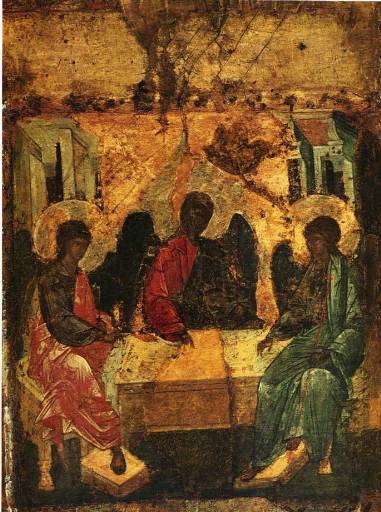 The border scene defining the basic theological idea of an icon is located at the left top corner.
The border scene defining the basic theological idea of an icon is located at the left top corner.This image concerning the general composition and colour symbolics is almost identical to the "Trinity" of Andrey Rublev (the eucharistic bowl was on the lost part of a paint layer). We see here the evident prototype of Rublev icon. That it is a prototype, but not the imitation, is visible already from this, that Rublev some composite discoveries (for example, the circular structure and bowl structure of icon) are not used in this stamp.
More early dating of "Archangel Michael" also follows from other reasons and is admitted by the majority of researchers. The personage to the left of the central one is dressed, as well as at Rublev, in green himation (mantle) – a sign of his angelic nature.
The main compositional distinction between two icons – position of heads of participants of a meal: on Rublev icon two of them turn their faces upon one on our right, here – to one on our left. We will notice, that such position of a head of central figure as on this stamp, has no precedents in iconography of St. Trinity. Symbolics of gestures – the same as on Rublev icon: the commanding gesture of a hand belongs to the interlocutor on our left, whereas gesture of the final consent – to one on our right.
In both cases the central person carries out a role of "transmitter" of a primary impulse. Comparing these two variants of the icon, we can see here a hint on disclosing of some deepest mysteries of the Holy Trinity, the rhythm of tripersonal life, structure of triple relations. However, according to church teaching, the Holy Trinity cannot be depicted in principle. On the icon we behold dynamics of an intradivine life, which is reflected on the created image of Trinity in the form of three persons, the highest rank in mankind.
In the given stamp the selected figure (heads of two others are inclined to him) is the mysterious personage, which we could not yet identify. We know only that he in his human nature should be "equal-dignity" to Jesus and Adam. Certainly, Jesus infinitely surpasses in His divine nature one and another. But let us recollect, where is located this image! It is the stamp at the corner of the big icon, which discloses the sense of all icon as a whole. And as it is the icon of Archangel Michael, hence, the interlocutor on our right is … Michael! But we have already established, that one who sit at a table with Jesus and Adam, is man, whereas on central part of the big icon the Angel is depicted. So who is represented here: the angel Michael or the man Michael?
The answer is unexpected and paradoxical: one and another simultaneously – the angel and the man. It is possible to tell, that it is the angel who, remaining an angel, becomes as well the man, just as in Jesus Christ the God, remaining God, became as well the perfectly real man. Thus the icon "Archangel Michael with acts" comprises the prophetical revelation about the future "incarnation" of Archangel Michael.
This revelation belongs certainly to Saint Sergius of Radonezh. There is an episode in his "Life-describing", which shows the "special relations" of Sergius with archangel Michael. When Sergius served a liturgy with his brother Stephan and nephew Feodor, the Sergius pupils Isaac and Makary have seen the fourth man dressed in light, shining clothes. They have understood it was an angel, and Sergius has confirmed it by saying that this angel had been serving with him constantly.
This peculiar connection of Sergius with archangel Michael is reflected in the icon which was written soon after canonization of Sergius, taking place on July 5th, 1422. Here Sergius stands in front of Theotokos, and the Archangel Michael is represented above.
In our article "Who is represented on Rublev icon Trinity?" we have suggested a hypothesis, that the central figure on this icon represents, according to Andrey Rublev conception, the resurrected Adam, forefather of mankind. To his right – Jesus Christ as Man. Adam is "created" image of God the Father, the Man Jesus – created image of God the Son (i.e. He as Man is the image of
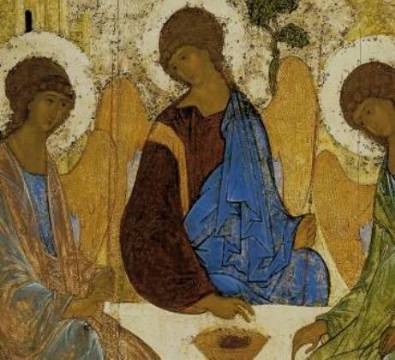 Itself as God). Now we can complete the picture, having accepted, that in understanding of spiritual successors of Sergius, the coming prince Michael should become the created image of the third Person of the Trinity – the Holy Spirit.
Itself as God). Now we can complete the picture, having accepted, that in understanding of spiritual successors of Sergius, the coming prince Michael should become the created image of the third Person of the Trinity – the Holy Spirit. Additional arguments in favour of a hypothesis about incarnation of archangel Michael.
a) On Rublev "Trinity" the figure to the Adam's left is dressed in the green mantle. It is known, that in symbolical language of ancient iconography the affinity to the angelic world was designated by green colour.
Blue colour of a chiton (tunic) which we have interpreted as a symbol of "new mankind in the Christ", shows that becoming the Man and having received thereby a possibility to have Communion, to become a partaker of Jesus body and blood, archangel Michael accepts also Jesus nature as "new Adam", "the new man".
In both icons we do not find the direct symbolical description for the kind of archangel Michael incarnation. We only may say that the origin of man Michael is closer to Jesus birth, than to Adam creation. Position of feet at lateral figures on Rublev icon specifies that Jesus and Michael "descend from the sky" whereas Adam "grows from the earth" – his feet are hidden.
b) The mountain represented on Rublev icon, usually is interpreted as a symbol of "spirit admiration", asceticism, a monkhood which often was called as "angelic service". It is possible to assume, that in this case the mountain reminds about "a miracle of archangel Michael in Choane" – one of the most widespread in Russia iconographic topic.
c) Two meal participants are talking among themselves, but their fingers are directed towards the third. The symbolics of gestures on icon allows to draw a conclusion, that the third participant of a meal is as though executor of the thought going from two first ones.
On Rublev icon it means: Jesus rules, Adam agrees, Michael expresses readiness to execute command. What is this command? Namely that: "to descend from the sky", "to become the man", to fight Antichrist and to head the Thousand-year Kingdom.
The council of three equal-dignity persons: Adam - Jesus - Michael, is typological parallel with a council of three persons of "smaller rank": Abraham - Isaac - Jacob, which had served for Rublev as a first, preliminary image of the Holy Trinity. Abraham, "the father of all believers ones" – a direct parallel with Adam, "the father of mankind". Isaac, which has expressed to the father his readiness to be victim, – is prototype of Jesus. Basic typological sign of Jacob – he is ancestor of twelve tribes of Israel. John's revelation described "the Angel, ascending from the east" (7:2) who should "to seal the servants of our God in their foreheads" (7:3). The "sealed" 144 thousand ones are divided into 12 tribes of New Israel (7:4-8): "Old Israel" was the selected people among Adam's descendants whereas the "New Israel" is collected from among Christians, members of "Christ body". If "an angel with the seal" is Michael, the parallel Michael - Jacob receives the reliable basis in Bible.
The icon "Trinity" of Andrey Rublev in aggregate with an Kremlin icon "Archangel Michael with acts" opens the deep prophetical plan of Sergius of Radonezh and of close to him outstanding figures of an epoch. By collecting of Russian people together, showing a way of overcoming of individualism and arrogance, creating the sobornal, conciliar soul of Russian people, they at the same time taught, that christian love in mutual humility and mildness, may turn as terrible and
 irresistibl force against the tyrannical power of evil.
irresistibl force against the tyrannical power of evil.